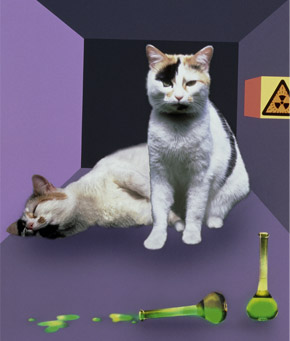Science Fiction and Fact

1935
Schrödinger's Cat
Back in physics, Erwin Schrödinger takes issue with the
Copenhagen Interpretation. To illustrate his concern,
Schrödinger devises a clever thought experiment in 1935: A cat
sits in a sealed chamber that contains a flask of hydrocyanic acid,
a poison that will kill the cat if the flask is broken. A hammer
mechanism is rigged to fall and break the flask if a Geiger counter
detects the decay of a single radioactive atom that is within the
box. When a radioactive atom decays, it emits a special type of
particle. According to the Copenhagen Interpretation, this particle
exists as a waveform, thus in all possible states, until it is
measured or observed. So, until someone looks into the chamber, the
radioactive atom has both decayed and not decayed, and the cat is
both dead and alive at the same time. This example, Schrödinger
reasonably remarks, is "quite ridiculous."